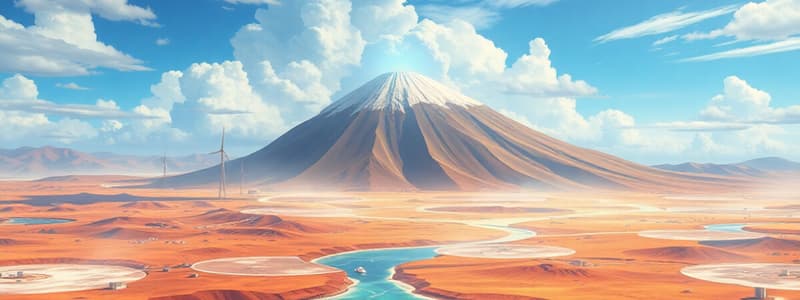Podcast
Questions and Answers
What are the three ways geothermal energy reaches the Earth's surface?
What are the three ways geothermal energy reaches the Earth's surface?
- Volcanoes, hot springs, geysers (correct)
- Tidal energy, biomass, fossil fuels
- Ocean waves, wind turbines, solars
- Nuclear fission, geothermal wells, hydroelectric dams
What is the first step in generating electricity at a geothermal power plant?
What is the first step in generating electricity at a geothermal power plant?
- Cooling the steam
- Drilling wells to pump steam or hot water (correct)
- Turning the turbine
- Condensing steam back to water
Which of the following is NOT an advantage of geothermal energy?
Which of the following is NOT an advantage of geothermal energy?
- Consistently reliable
- Renewable source
- Location-specific (correct)
- Requires minimal land
What causes steam to form when hot water reaches the surface in a geothermal power plant?
What causes steam to form when hot water reaches the surface in a geothermal power plant?
Which of the following is a human-induced factor influencing geothermal energy depletion?
Which of the following is a human-induced factor influencing geothermal energy depletion?
Which location is an example of a depleted geothermal field?
Which location is an example of a depleted geothermal field?
What must be carefully managed to prevent depletion in geothermal energy sources?
What must be carefully managed to prevent depletion in geothermal energy sources?
Which of these is a disadvantage of geothermal energy?
Which of these is a disadvantage of geothermal energy?
What component is used in a geothermal power plant to generate electricity?
What component is used in a geothermal power plant to generate electricity?
What is a major environmental risk associated with geothermal energy?
What is a major environmental risk associated with geothermal energy?
What potential risk is associated with drilling geothermal wells?
What potential risk is associated with drilling geothermal wells?
What is a consequence of extracting high-pressure fluids from geothermal reservoirs?
What is a consequence of extracting high-pressure fluids from geothermal reservoirs?
Which of the following can be a chemical contaminant in geothermal fluids?
Which of the following can be a chemical contaminant in geothermal fluids?
How can geothermal development affect natural geothermal features?
How can geothermal development affect natural geothermal features?
What must be done to prevent the pollution of waterways from geothermal operations?
What must be done to prevent the pollution of waterways from geothermal operations?
What is a recommended method for conserving geothermal resources?
What is a recommended method for conserving geothermal resources?
Why should reinjection sites be placed far from extraction sites?
Why should reinjection sites be placed far from extraction sites?
What is a significant environmental impact of geothermal fluid extraction?
What is a significant environmental impact of geothermal fluid extraction?
Which of the following is NOT a subsurface hazard related to geothermal energy?
Which of the following is NOT a subsurface hazard related to geothermal energy?
What is a primary concern in the over-extraction of geothermal resources?
What is a primary concern in the over-extraction of geothermal resources?
Flashcards
Geothermal drilling and earthquakes
Geothermal drilling and earthquakes
Drilling geothermal wells can intersect faults and create new fractures, potentially increasing the risk of earthquakes.
Geothermal extraction and subsidence
Geothermal extraction and subsidence
Extracting high-pressure fluids from geothermal reservoirs can lower pressure, causing the ground to sink or subside.
Chemical contamination from geothermal fluids
Chemical contamination from geothermal fluids
Geothermal fluids can contain heavy metals and toxic substances, posing a risk of contamination.
Damage to geothermal features
Damage to geothermal features
Signup and view all the flashcards
Waterways pollution from geothermal fluids
Waterways pollution from geothermal fluids
Signup and view all the flashcards
Conservation of geothermal resources
Conservation of geothermal resources
Signup and view all the flashcards
Over-production of geothermal resources
Over-production of geothermal resources
Signup and view all the flashcards
Reinjection of spent geothermal fluids
Reinjection of spent geothermal fluids
Signup and view all the flashcards
Placement of reinjection sites
Placement of reinjection sites
Signup and view all the flashcards
Geothermal energy management
Geothermal energy management
Signup and view all the flashcards
What is geothermal energy?
What is geothermal energy?
Signup and view all the flashcards
Why is geothermal energy renewable?
Why is geothermal energy renewable?
Signup and view all the flashcards
How does geothermal energy work?
How does geothermal energy work?
Signup and view all the flashcards
Where are geothermal power plants located?
Where are geothermal power plants located?
Signup and view all the flashcards
Why is geothermal energy considered clean and reliable?
Why is geothermal energy considered clean and reliable?
Signup and view all the flashcards
What is a major concern with geothermal energy?
What is a major concern with geothermal energy?
Signup and view all the flashcards
What is reservoir cooling?
What is reservoir cooling?
Signup and view all the flashcards
What is fluid depletion?
What is fluid depletion?
Signup and view all the flashcards
How does over-extraction impact geothermal energy?
How does over-extraction impact geothermal energy?
Signup and view all the flashcards
What can be done to prevent depletion of geothermal resources?
What can be done to prevent depletion of geothermal resources?
Signup and view all the flashcards
Study Notes
Geothermal Energy: Production and Management
-
Geothermal energy harnesses Earth's internal heat to generate electricity. Heat reaches the surface via volcanoes, fumaroles, hot springs, and geysers.
-
Electricity generation involves drilling wells to extract steam or hot water. Pressure drop converts water to steam, powering turbines connected to generators. Cooled steam condenses back to water, which is reinjected into the Earth.
Geothermal Advantages and Disadvantages
-
Advantages: Renewable, clean (low greenhouse gas emissions), reliable (consistent energy supply), versatile (electricity, heating, & cooling), and requires minimal land.
-
Disadvantages: Location-specific, high upfront costs, potential environmental risks (earthquakes, water contamination).
Geothermal Energy Depletion
-
Geothermal resources are renewable but need careful management to prevent depletion.
-
Natural Depletion: Reservoir cooling, fluid depletion
-
Human-Induced Depletion: Over-extraction, inadequate reservoir management, poor well design, lack of reinjection
-
Examples of Depleted Fields: Geysers (California), Larderello (Italy), Wairakei (New Zealand), Tiwi (Philippines).
Geothermal Risks and Threats
-
Subsurface hazards: Earthquakes from drilling fault lines and ground subsidence from pressure drop in hot reservoirs.
-
Environmental hazards: Chemical contamination of geothermal fluids (heavy metals, toxic substances), damage to natural geothermal features (geysers, hot springs), and potential waterway pollution from chemicals like mercury, boron, lithium, & arsenic.
Geothermal Conservation Strategies
-
Avoid over-extraction: Preventing excessive hot water production that could cool the reservoir.
-
Reinjection: Returning spent fluids to the reservoir.
-
Strategic reinjection site selection: Keeping reinjection and extraction sites apart to enable proper re-heating.
Studying That Suits You
Use AI to generate personalized quizzes and flashcards to suit your learning preferences.




